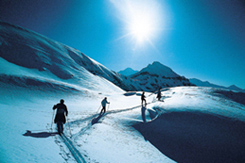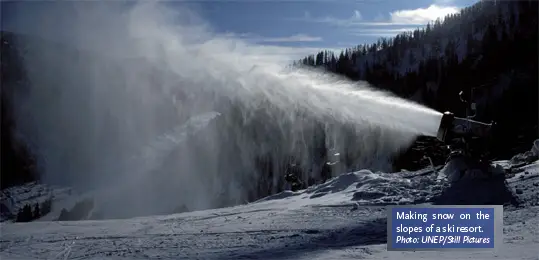 Climate Change and Tourism: In 2000, there were 698 million international travellers and numbers are forecast to leap to 1 billion by 2010 and 1.6 billion by 2020. Tourism is a large part of many people’s lives and a significant part of many economies. Some estimates suggest tourism forms 10 percent of the world’s economic activity, and all rely on a mixture of natural beauty, good weather and safe conditions to attract holiday-makers. Climate change will negatively affect coastal resorts, tropical rain forests, wildlife safaris, Arctic and Antarctic regions and alpine ski resorts. So the changing climate is likely to pose a profound challenge to sustainable tourism in some locations, and may provide new opportunities in others.
Climate Change and Tourism: In 2000, there were 698 million international travellers and numbers are forecast to leap to 1 billion by 2010 and 1.6 billion by 2020. Tourism is a large part of many people’s lives and a significant part of many economies. Some estimates suggest tourism forms 10 percent of the world’s economic activity, and all rely on a mixture of natural beauty, good weather and safe conditions to attract holiday-makers. Climate change will negatively affect coastal resorts, tropical rain forests, wildlife safaris, Arctic and Antarctic regions and alpine ski resorts. So the changing climate is likely to pose a profound challenge to sustainable tourism in some locations, and may provide new opportunities in others.
“In mountain regions, it seems very probable that ultimately demand for winter sports will diminish. The season will shorten, opportunities for young people to learn the sports will diminish, demand pressures on high altitude resorts will increase (which in turn could raise environmental pressures and cause further damage). Summer seasons, meanwhile, could lengthen, and generate increased demand, although this could bring further negative environmental consequences.
 The balance of costs and benefits is illustrated by the situation in the Arctic, where a longer summer season might benefit cruise tourism and activities such as whale-watching, but shorter winters could reduce the range of Arctic fauna and flora which attracts some visitors”(Proceedings of the 1st International Conference on Climate Change and Tourism Djerba, Tunisia, 9-11 April 2003).
The balance of costs and benefits is illustrated by the situation in the Arctic, where a longer summer season might benefit cruise tourism and activities such as whale-watching, but shorter winters could reduce the range of Arctic fauna and flora which attracts some visitors”(Proceedings of the 1st International Conference on Climate Change and Tourism Djerba, Tunisia, 9-11 April 2003).
The Alps are currently warming at roughly three times the global average. Climate models project an increase in winter temperatures of about 1° to 3° C from 1990 conditions by 2050, with greater warming at higher elevations. An analysis of snow cover in the Alps concluded that each increase of 1° C corresponds to a 150 m move up the mountain of the line marking the lower limit of adequate snow for ski resorts. This means that each degree of warming will result in a further decline of snow conditions to the point that more and more current ski operations will not be viable.
Adaptation measures include more artificial snow making and expanding and building ski areas at higher elevations and on north-facing slopes. As the climate warms and the snow cover declines, many low-elevation ski resorts will not be able to adapt and will be forced to switch to other types of tourism or close.

Tourism cannot be seen in isolation, and major climatic changes will affect the pattern of demand with wider social and economic impacts. For example, employment and labour demand will change, raising issues in housing, transport and social infrastructure. Knock-on effects could influence other sectors, such as agriculture supplying tourism demand, handicraft industries, and local small business networks and so on.
